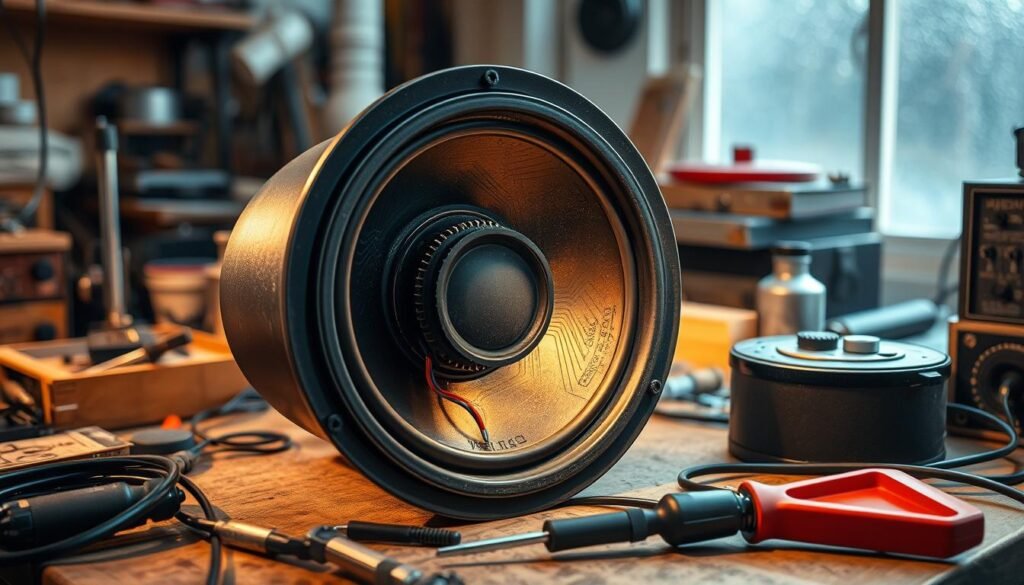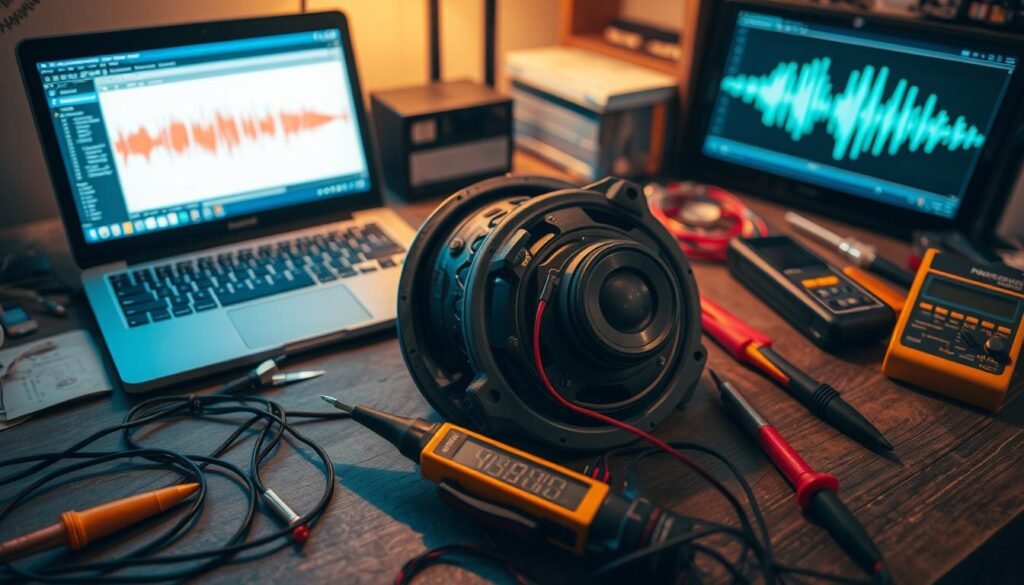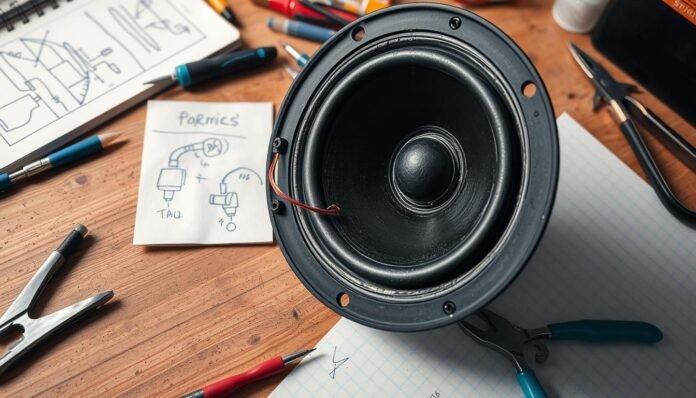Feeling stuck with faulty audio equipment? You’re in good company. Many find themselves troubleshooting speaker issues. This guide is here to navigate common problems. We’ll provide easy-to-follow solutions to help fix your speaker. Whether you’re dealing with distorted sound or no audio at all, our tips are here to guide you. Let’s tackle these issues and get your sound system back on track!
Key Takeaways
- Understanding common speaker issues is essential for effective troubleshooting.
- Preparation is key; make sure to gather the necessary tools before starting repairs.
- Assessing power supply and connection is critical to fixing speaker problems.
- Learn DIY techniques for repairing common speaker damages.
- Regular maintenance can help prevent future problems.
- Know when it’s time to seek professional speaker repair services.
- Consider replacement options if repairs are not feasible.
Understanding Common Speaker Issues
Knowing when there’s a problem with a speaker can really improve your listening experience. If you spot issues early, you can fix them before they get worse. This saves you money and keeps your speakers sounding great. Speaker problems show up in different ways. Each one tells us something important about what might be wrong.
Identifying the Signs of a Faulty Speaker
Finding out what’s wrong with your speaker is key. Here’s what to look for:
- Silence: If there’s no sound, it might mean there’s an issue with power or a disconnection.
- Distortion: Sounds that are muffled or not clear could mean the speaker cone is broken.
- Echoing Sound: An echo might show that the inside parts aren’t working right or the speaker’s placed wrong.
Common Symptoms and Their Causes
Knowing what different problems mean helps you figure out what’s wrong with your speaker:
| Symptom | Possible Cause |
|---|---|
| Silence | Problems with power connections or broken cables |
| Distortion | Broken speaker cone or inner parts |
| Echoing Sound | Bad placement of the speaker or sound bouncing around |
Preparing for Speaker Troubleshooting
Getting ready to fix speakers is key. Make sure you have the proper tools. Also, check that your sound system is safe before starting. This helps make fixing audio issues easier and safer.
Gathering Necessary Tools for the Job
For a successful speaker repair, you’ll need certain tools:
- Screwdrivers: Various sizes are needed for different screws.
- Multimeter: It’s key for checking electric connections.
- Wire cutters and strippers: They’re good for working with speaker wires.
- Cleansing supplies: Use microfiber cloths and solutions for cleaning.
- Replacement parts: Get fuses or connectors if needed.
Ensuring Your Sound System is Safe to Work On
Being safe is crucial when fixing audio. Here’s what to do before starting repairs:
- Unplug the sound system to avoid electric shock.
- Be careful with connectors to prevent damage.
- Make sure your working area is safe and distraction-free.
How to Fix My Speaker: Step-by-Step Guide
Fixing speaker issues is easy if you follow the right steps. Start with simple checks and then dive into more complex inspections. This guide will show you how to find and fix problems with your speaker.
Performing a Basic Sound Check
To start, do a basic sound check. Play a song or audio that you know should sound great. Listen carefully to the sound’s clarity and how loud it is. If the sound is distorted, cuts out suddenly, or there’s no sound at all, make a note. These issues could mean your speaker needs to be fixed.
Inspecting Cables and Connections
Next, look at the cables and connections. Bad cables can cause many sound problems. Here are the steps to check them:
- Make sure connections at the speaker terminals are tight.
- Look for any frayed wires or breaks that could mess with the sound.
- Check that the speaker is connected right to the power source.
Keeping all connections secure often fixes simple speaker problems. This will make your sound better.

Checking Power Supply and Settings
Before diving into complex troubleshooting for a speaker issue, always check the power supply and settings first. A quick check can often fix the problem. Many speaker issues stem from power connection problems or incorrect volume settings. Solving these issues can quickly restore your sound system’s function.
Verifying Power Connection Issues
First, examine your speaker’s power connections. A disconnected or damaged cable can cause no sound. Follow these steps:
- Ensure the power cord is securely connected to both the speaker and the outlet.
- Look for any signs of wear or damage on the power cable.
- Try plugging the speaker into a different outlet to rule out outlet issues.
Adjusting Volume and Settings on Your Device
Volume settings are often behind common sound issues. Users may have their devices on mute or low volume without realizing it. To fix this, ensure the following:
- Verify that the volume is turned up on the speaker and your audio device.
- Look for any mute settings that may have been activated.
- Examine the equalizer or sound settings on your device to ensure appropriate adjustments.
Speaker Repair Techniques for DIY Enthusiasts
For those who love DIY projects, speaker repair is both rewarding and saves money. Understanding repair techniques improves your audio skills. It lets you fix torn speaker parts or bad connectors, ensuring great sound quality.
How to Fix Ripped Speaker Membranes
Broken speaker membranes can hurt sound quality. Here’s how to fix them:
- Inspect the damage to assess the rip’s size.
- Choose the right adhesive for speaker materials.
- Apply the adhesive evenly.
- If needed, use a repair patch and press it firmly on the membrane.
- Give the adhesive time to dry before testing.
Replacing Faulty Connectors
Faulty connectors can cause sound issues. Here’s a simple way to replace them:
- Turn off the speaker and open it to reach the connectors.
- Check the connectors for damage or corrosion.
- Remove the bad connectors carefully.
- Solder or clip the new connectors in place.
- Put the speaker back together and test the sound.
| Repair Type | Tools Needed | Estimated Time | Skill Level |
|---|---|---|---|
| Ripped Membrane Repair | Adhesive, Patch, Scissors | 30 minutes | Beginner |
| Connector Replacement | Soldering Iron, New Connectors | 1 hour | Intermediate |
Learning these speaker repair methods is good for skill building and speaker care. It lets you enjoy your audio system much longer.
Audio Troubleshooting for Simple Problems
When facing audio troubleshooting challenges, users often encounter two prevalent concerns: intermittent sound issues and distorted audio. Understanding how to effectively address these problems can empower individuals to fix my speaker without needing professional help. Below are strategies to tackle these common speaker issues.
Troubleshooting Intermittent Sound Issues
Intermittent sound problems can be frustrating. They can come from a variety of sources. Follow these steps to identify and resolve these issues:
- Check speaker placement to ensure they’re not obstructed.
- Inspect cables for any signs of damage or loose connections.
- Adjust settings on your device to confirm sound output preferences.
- Eliminate potential interference from other electronic devices.
Resolving Distorted Audio Problems
Audio distortion usually points to a more serious speaker issue. Use these tips to fix the problem:
- Examine the equalizer settings on your device, lowering frequencies that may cause distortion.
- Ensure your speaker is compatible with the audio source.
- Perform a thorough inspection of the speaker for any physical damage, like rips or tears.
- Test with different audio sources to isolate the problem.

By applying these troubleshooting techniques, users can effectively tackle common audio problems with their speakers. Understanding these issues leads to a better listening experience and extends the life of audio equipment.
Speaker Maintenance Tips to Prevent Issues
Proper care is key to keeping your audio system running well. Regular maintenance stops big repairs and audio problems later. By doing simple things, you keep speakers working great, improving sound and lasting longer.
Regular Cleaning and Care for Your Speakers
Dust and dirt can hurt your speakers’ sound. Cleaning often fixes this. Here are ways to clean:
- Use a soft, dry cloth to wipe down the exterior of the speakers.
- Gently vacuum the grilles with a brush attachment to remove dust particles.
- Avoid using harsh chemicals. Instead, opt for a slightly damp cloth to clean stubborn stains.
- Inspect cables for any signs of wear and replace faulty ones promptly.
Understanding Operating Conditions to Avoid Damage
Keeping speakers in the right conditions helps them last. High or low temperatures and wetness can damage them. Follow these rules:
- Keep speakers in a climate-controlled environment to avoid temperature fluctuations.
- Avoid placing speakers near heat sources like radiators or direct sunlight.
- Maintain humidity levels between 30% and 50% to prevent moisture-related damage.
- Ensure that your sound system is used within its recommended power range to avoid overloading.
These tips are key for good speaker care. Cleaning regularly and watching conditions stops issues before they start. This makes your audio perform well for a long time.
When to Seek Professional Speaker Repair
Sometimes, your audio system might have issues too big for DIY fixes. Knowing when to get professional speaker repair can save you both time and prevent further harm. There are several clues that your speaker needs a specialist’s touch. Recognizing these signs can make fixing audio issues easier.
Identifying Repairs Beyond DIY Capabilities
Not every speaker problem is a quick fix. Look for signs that show you need expert help:
- Persistent distortion in sound quality, even after basic troubleshooting.
- Internal issues, like problems with the speaker’s crossover or a damaged voice coil.
- Problems turning on or irregular power supply issues.
- Strange smells or signs of burning, which suggest serious damage.
Finding a Reliable Speaker Repair Service
Finding a trustworthy repair service for your speaker is key. Follow these tips to choose wisely:
- Look up local repair shops and read what customers say.
- Check if they are certified or have experience in speaker repair.
- Ask if there is a warranty on the repair work they do.
- Know about the repair costs and process beforehand.
Knowing when to get professional help is crucial for your audio gear’s upkeep. Doing your homework on repair options can help fix your sound system and bring it back to its best.
Considering Speaker Replacement Options
Deciding whether to replace or repair your speakers can be tricky. Some situations require a speaker replacement rather than repair. For instance, severe damage usually means replacing is better. Knowing when to replace can save time and money, and keep your audio great.
Knowing When to Replace instead of Repair
Consider replacement if:
- The speaker is too damaged for a simple fix.
- It’s old and not working like it used to.
- Fixing it costs more than a new one.
Choosing the Right Replacement Speaker
Choosing a new speaker involves important details:
| Factor | Consideration |
|---|---|
| Specifications | Make sure it matches with what you already have. |
| Brand Compatibility | Use the same brand or something that works well with what you have. |
| Size and Space | Check that the new one will fit in your setup. |
Considering these points will make your audio better and your experience more enjoyable. Picking carefully is key to better sound.
Exploring Audio Fix Solutions for Your System
Improving your sound system is a mix of tech tweaks and smart updates. Using software tools for an audio fix can greatly boost sound quality. These include equalizers and digital sound processors, aimed at perfecting sound playback and fitting it to your space.
Utilizing Software for Audio Adjustments
There are many software options for better audio. Equalizers let you change frequency levels, making sound clear and balanced. Digital sound processors offer ways to tailor sound, letting users craft their own audio profiles. These tools can dramatically improve your sound system, enhancing your listening joy.
Integrating External Components for Better Sound
Besides software, adding hardware can also boost sound quality. Subwoofers bring deep bass, and amplifiers lift the sound’s volume and depth. This path not only makes your music richer but also uses your gear to its fullest. Trying out these extras can show clear advantages, revitalizing your sound setup.
Conclusion
In this guide, we looked at how to solve speaker and audio problems. We learned how to identify issues and when to get professional help. With this info, you can improve how you listen to music and other media.
Using what we talked about can stop small issues from getting worse. Taking care of your speakers makes them last longer. Knowing when to get expert advice can save you both time and money. Good audio quality makes listening to your favorite tunes and shows much better.
We encourage you to come back for more tips on audio topics. It could be about fixing speakers, troubleshooting, or making your audio setup better. Knowing your equipment well leads to a great listening experience.
